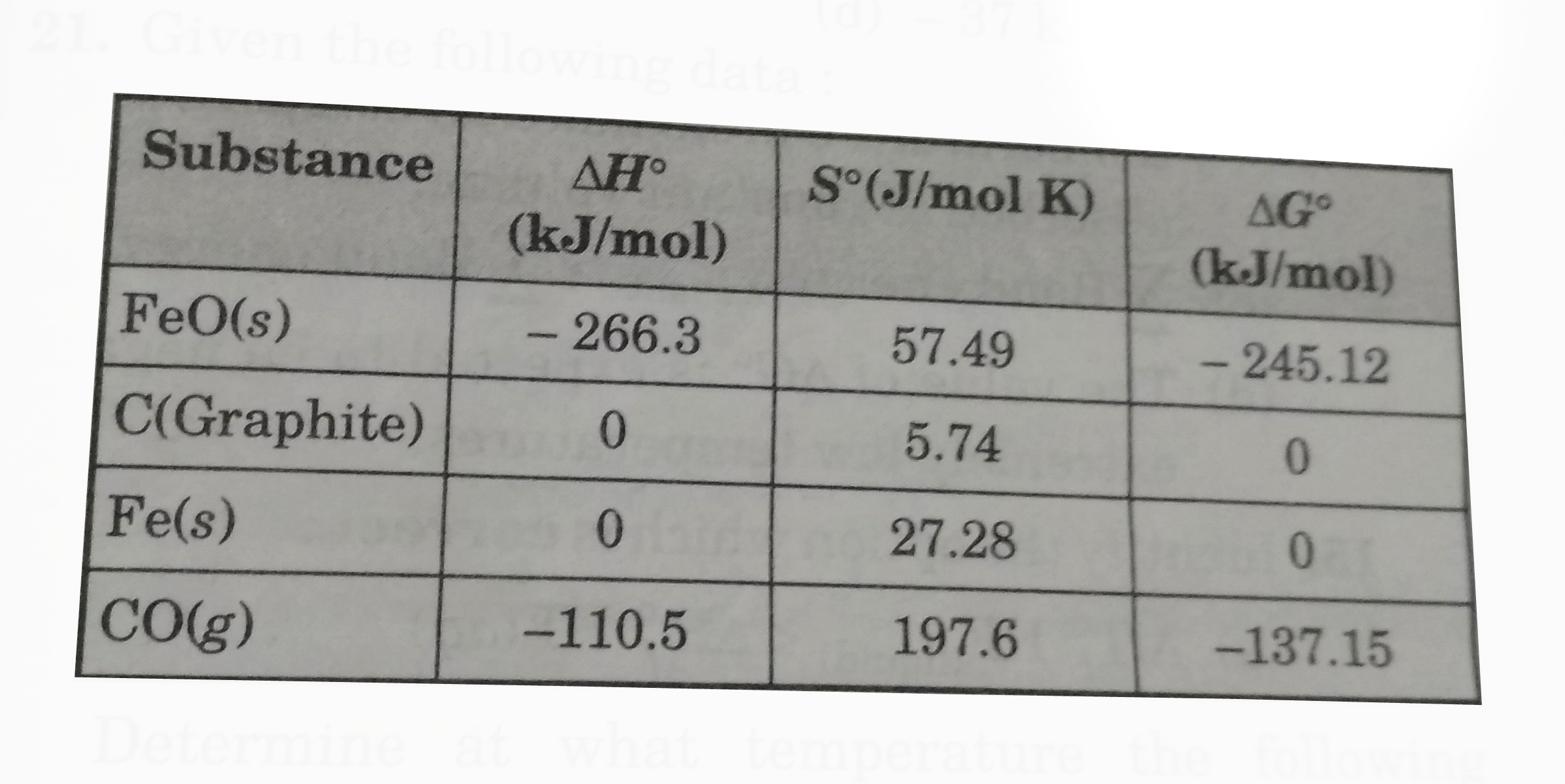Given the following data :

Determine at what temperature the following reaction is spontanous?
298 K
668 K
966K
is +ve, hence the reaction will never be spontaneous.
The correct Answer is:C
For spontaneous reaction,
Topper's Solved these Questions
- BOOK - OP TANDONCHAPTER - Chemical Thermodynamics and ThermochemistryEXERCISE - Objective Question Level B Set II8videos
Chemical Thermodynamics and Thermochemistry
- BOOK - OP TANDONCHAPTER - Chemical Thermodynamics and ThermochemistryEXERCISE - Assertion Reason Type Question29videos
Chemical Thermodynamics and Thermochemistry
- BOOK - OP TANDONCHAPTER - Chemical Thermodynamics and ThermochemistryEXERCISE - Set 218videos
Chemical Thermodynamics and Thermochemistry
- BOOK - OP TANDONCHAPTER - CHEMICAL KINETICSEXERCISE - LINKED COMPRESHENSION TYPE QUESTIONS ( SECTION-VI)4videos
CHEMICAL KINETICS
- BOOK - OP TANDONCHAPTER - CLASSIFICATION AND NOMENCLATURE OF ORGANIC COMPOUNDS EXERCISE - INTEGER2videos
CLASSIFICATION AND NOMENCLATURE OF ORGANIC COMPOUNDS
Similar Questions
Determine ΔS total and show whether the following reaction is spontaneous is 25∘C
Fe2O3(s)+3CO(g)→2Fe(s)+3CO2(g)
ΔH∘=−24.8kJ,ΔS−1=15JK−1View SolutionAt 1250K
2FeO(s)→2Fe(s)+O2(g), ΔG=+320kJmol−1 of O2
2C(s)+O2(g)→2CO(g), ΔG=−430kJmol−1 of O2
The following coupled reaction is spontaneous because
2FeO(s)+2C(s)→2Fe(s)+2CO(g)View Solution
Knowledge Check
- Question 1 - Select One
Given the following data
SubstanceΔH∘(KJ/mol)S∘(J/molK)ΔG∘(kJ/mol)FeO(s)−266.357.49−245.12C(Graphite)05.740Fe(s)05.740CO(g)−110.5197.6−137.15
Determine at what temperature the following reaction is spontaneous?
FeO(s)+C(Graphite)→Fe(s)+CO(g)A298KB668KC966KDΔG∘ is +ve hence the reaction will never be spontaneous - Question 2 - Select One
Given the following data:
SubstanceΔH∘(KJ//mol)S∘(J//mol K)ΔG∘(KJ//mol)FeO(s)−266.357.49−245.12C(Graphite)05.740Fe(s)027.280CO(g)−110.5197.6−137.15
Determine at what temperature the following reaction is spontaneous?
FeO(S)+C(Graphite)→Fe(s)+CO(g)A298 kB668 KC964 KDΔG∘ is +ve , hence the reaction will never be spontaneous - Question 3 - Select One
In which of the following cases, the reaction is spontaneous at all temperatures
AΔH>0,ΔS>0BΔH<0,ΔS>0CΔH<0,ΔS<0DΔH>0,ΔS<0
Calculate the temperature above which the reaction of lead oxide to lead in the following reaction become spontaneous.
PbO(s)+C(s)→Pb(s)+CO(g)
Given ΔH=108.4kJmol−1,ΔS=190JK−1mol−1View SolutionCalculate the temperature above which the reduction of lead oxide to lead in the following reaction become spontaneous.
PbO(s)+C(s)→Pb(s)+CO(g)
Given ΔH=118.4kJmol−1,ΔS=200JK−1mol−1.View SolutionWhich of the following is//are the rate determining step (s) of the given reaction ?
 .View Solution
.View SolutionWhich of the following statements is (are) correct about the following reaction ?
2Pbo(s)+C(s)→2Pb(s)+CO2(g)View SolutionIn which of the following cases is the reaction spontaneous at all temperatures?
View Solution

